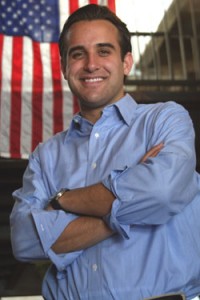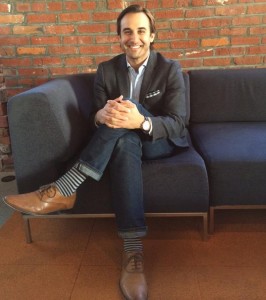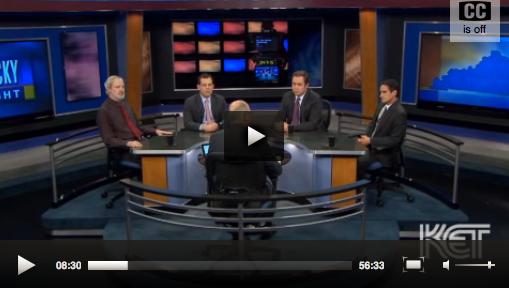By Julie Rath, on Fri Nov 22, 2013 at 8:30 AM ET “I hate shopping, except for the part where I am back in my apartment with new clothes.”
Does that sound like you? A prospective client once emailed that line to me. It made me laugh, but I get it. Shopping can be tiring, stressful and frustrating. Planning an effective shopping trip takes strategic thought. While it should be easy, often things get in the way. But, take it from me, shopping can be a smooth and seamless process. Below are 9 of my best tools and tricks for a well-executed shopping trip.
 Here’s a dressing room snap from yesterday as I was getting things ready for a client. Here’s a dressing room snap from yesterday as I was getting things ready for a client.
1) Find a good salesperson. Some of my best relationships have resulted from following my intuition in a store and simply walking up to someone, introducing myself, and explaining what I was looking to accomplish. A good salesperson will make shopping hassle-free – without an overbearing salespitch (more on this in #6). They’ll also give you advance info on when the sales are and in many cases ‘pre-sell’ items to you – which means you get dibs on things before they go on sale to the general public.
Read the rest of…
Julie Rath: Secrets from a Shopping Pro
By Saul Kaplan, on Mon Nov 18, 2013 at 8:30 AM ET My friend and Boston Globe innovation columnist, Scott Kirsner, has launched an interesting new on-line platform for corporate innovation executives. You will want to check out and subscribe to Innovation Leader where you will find lots of food for innovation thought and where this post originally appeared.
I used to think that if I just yakked long and loud enough, I could convince CEOs to embrace transformational innovation. It took me 25 years as a road warrior consultant, author, and accidental government bureaucrat to realize that proselytizing doesn’t work. If leaders don’t want to change, all the consulting jargon and fancy PowerPoints in the world won’t convince them to.
In those situations, no matter what lofty rhetoric the CEO uses in public or at company retreats about “creating an innovation culture” and encouraging everyone to think outside of the box, the best result you can hope for are incremental innovations to improve the performance of today’s business model. You never get transformational new business models — and you always get frustrated if you were hoping for bolder change. If you want transformational innovation, you have to find leaders who want transformational change and are receptive to organizing differently for tweaks than for transformation. After learning this lesson the hard way over many years, I no longer try to convince CEOs who don’t want to change, and instead try to find those CEO’s who do.
 Here’s my list of 10 questions you can ask a CEO to tell if they are really serious about transformational innovation: Here’s my list of 10 questions you can ask a CEO to tell if they are really serious about transformational innovation:
1) Do you agree transformational innovation goes beyond breakthrough products to include business model innovation — entirely new ways to create, deliver and capture value?
2) Will your employees tell me that failure is a career-limiting move, or that the company celebrates experimentation?
3) How much time do you spend strengthening and protecting the current business model, versus designing the next one?
4) Do you have clear and discrete objectives for both incremental and transformational innovation? Do you organize differently for each?
5) Does your organization invest in R&D for new business models as it does for new products, services, and technologies?
6) Are you prepared to have your organization disrupt itself? How do you see that playing out?
7) Do internal ideas and projects that threaten to cannibalize the current business model get squashed — or nurtured?
8) Do you have a process for allocating resources for transformational innovation projects that lies outside of the control of business units?
9) Do executives with responsibility for exploring transformational business models report to you, or to another line executive responsible for today’s business?
10) Are you willing to create a sandbox to explore transformational business models? Would you carve out a part of your current business/market to serve as an ongoing real-world innovation lab?
A few words of advice about using these questions in the real world… Tread lightly, since no CEO likes to be put on the spot and drilled with a laundry list of questions. Pick a few of the ten to put into your own words to help you discern whether the company you work for, or are thinking about working for (or with), has a leader who shares your appetite for transformational innovation. Better to know what kind of environment you’re going into in advance than to learn painful lessons later.
By RP Nation, on Wed Nov 13, 2013 at 10:00 AM ET The Recovering Politician is proud to publish an EXCLUSIVE EXCERPT from an exciting and educational book written by Friend of RP Robert D. Hudson and his daughter Lauren Hudson, “Our Best Tomorrow: Students Teaching Capitalism to America.” Enjoy!
 Click here to review & purchase “Well, I was thinking that maybe we could make our software faster and more efficient by re-engineering…” Oh! Finally, you’re here. My name is Jacob but people call me Jake. “Okay guys, staff meeting dismissed. Go back to your daily business of coming up with the best ideas in the world!’’ I’m delighted you could at last come and enjoy the wonders my company has created for computers, gaming systems and smart phones.
How much money do I make? Well now, that is a difficult question to answer. Considering I designed the first software for my company, Kinetic Software, I usually do make a bit more than my workers here, but mainly, it depends on how many copies of the software we sell. Some years we do well and some years we don’t. If we don’t do well, I might not make anything!
How did I create this groundbreaking software? Well, when I was growing up, I was always interested in the way things worked. One of my earliest memories was sitting on the kitchen floor with an old phone and attempting to take it apart while my mother cooked me lunch.
My father would come home from his work as a dentist and watch me bang the phone on the floor and study it carefully. Pretty soon I figured out how to take it apart and put it back together. I can remember how excited I had been. I ran around screaming about my accomplishment.
“I got it! I got it, Mommy! I got it, Daddy! I got it, Sissy!’’ I yelled. My father walked over to me from the other room, scooped me up in his arms and swung me around. He had the broadest smile on his face, as if I had just won Olympic gold.
As I got older, I became interested in science fiction and how the world would work someday. I imagined computers and cell phones and space travel to other planets. I recall my sister, Annabeth, who was about 13, watching TV one day, when I came in, turned the TV off, and told her my latest idea. She called me a twerp, but I didn’t care.
“Go bother something else! Don’t touch the TV anymore, Jake!’’ she said in exasperation. With my head hanging low, I walked into my dad’s study. He had one of Apple’s first computers. When I saw that computer sitting on the dark mahogany desk, I knew what my next project would be. Little did I know that the project of trying to learn how this computer worked would lead to the some of the biggest accomplishments of my life.
It was only a matter of time before I had moved on to developing software to do my part to help change the world! You see, I love what I do, and I live in a country which gives me the freedom to do it. Yes, I work hard, but can you believe I get to make money doing something I love? All you need is passion and freedom – mix a little talent and hard work in there and you’ll have something special!
Capitalism Pointer – America’s Jobs Come From Capitalism
Read the rest of…
EXCLUSIVE EXCERPT: Lauren Hudson & Robert D. Hudson, “Our Best Tomorrow”
By Saul Kaplan, on Mon Nov 11, 2013 at 8:30 AM ET You probably haven’t heard of Richard LaMotta but I bet you have heard of and enjoyed his innovation, the Chipwich ice cream sandwich. I rank the Chipwich right up there on my list of all-time favorite innovations along with Guttenberg’s printing press and Apple’s iPhone. Like most great innovations the Chipwich didn’t require inventing anything new, just recombining existing elements in a new way to deliver value. What could deliver more value than sandwiching soft vanilla ice cream between two, large chocolate chip cookies? As if that isn’t innovative enough add in the piece de resistance, rolling the whole thing in chocolate chips! Now that’s innovation. LaMotta died last week and his classic entrepreneur story is worth remembering and celebrating.
LaMotta was ahead of his time in 1982 when he deployed unheard of guerilla marketing tactics to take the idea for Chipwich from a retail confectionary store called The Sweet Tooth in Englewood, New Jersey to selling 200,000 per day across the country at its peak. The name Chipwich came from an early crowd sourcing effort when LaMotta held a contest offering a year’s supply of the product to the winning contributor. A student from New Jersey came up with the winning name and was rewarded not only with a year’s supply of the tasty treat but also put through college by the company for her contribution.
 LaMotta had a vision to take the Chipwich national but was told by marketing “experts” that it would take $50M in working capital that the company didn’t have. No worries, LaMotta took the campaign to the streets of Manhattan, literally, deploying street cart vendors complete with identifiable pith helmets and khaki pants. They created an innovative sales channel without the help of the experts establishing a new product category for premium handheld ice cream and an attractive new price point breaking the $1 barrier. Prior to Chipwich hand held ice cream products were low quality and low cost. Vendors consistently sold out of Chipwiches and the price point continued to move up. Fortune 100 food giants approached LaMotta to use the carts as a trial medium for their own products. LaMotta had a vision to take the Chipwich national but was told by marketing “experts” that it would take $50M in working capital that the company didn’t have. No worries, LaMotta took the campaign to the streets of Manhattan, literally, deploying street cart vendors complete with identifiable pith helmets and khaki pants. They created an innovative sales channel without the help of the experts establishing a new product category for premium handheld ice cream and an attractive new price point breaking the $1 barrier. Prior to Chipwich hand held ice cream products were low quality and low cost. Vendors consistently sold out of Chipwiches and the price point continued to move up. Fortune 100 food giants approached LaMotta to use the carts as a trial medium for their own products.
Chipwich went viral without the help of today’s social media platforms. Imagine the tweets. Chipwich received an estimated $50 million of earned advertising exposure receiving thousands of free endorsements. Mayor Koch even posed for a publicity photo, for no fee, as he took a big bite of a Chipwich. It was an attractive David vs Goliath story that the press ate up. LaMotta says he gained 30 pounds just doing free media interviews.
LaMotta learned the many hard lessons of entrepreneurship along the way, twice filing for and then emerging from bankruptcy, as the knockoffs came fast and furious. He also learned first hand what happens when an entrepreneur mixes it up with the world of large corporations. LaMotta laments what he called large corporate “analysis to paralysis” syndrome and cautioned aspiring entrepreneurs about the importance of non-disclosure agreements. In 2002 with a nationally recognized brand, more than a billion Chipwiches sold, and 3700 vendors in 36 markets, he sold the company to Coolbrands International, a Canadian distributor, who also owned the Eskimo Pies brand. Coolbrands then in turn sold both brands to Dreyer’s, a subsidiary of Nestle, who discontinued making the Chipwich because they already had another brand in the category. Like most entrepreneurs LaMotta struggled with losing control of his baby.
LaMatta was a classic entrepreneur who never quit. He said it best, “I got out there, I went for it, and persevered through the rough times.” He did indeed. Chipwich is a great innovation story. Rest in delicious peace, Richard LaMatta.
By Jason Grill, on Tue Nov 5, 2013 at 10:00 AM ET  Kansas City has always been an entrepreneurial city. Kansas City has always been an entrepreneurial city.
Companies such as Hallmark, Sprint, DST, Cerner, H&R Block, Garmin and Russell Stover Candies all call Kansas City home. However, a true renaissance in entrepreneurship and a renewed sense of a vibrant startup community has skyrocketed of late. A recent paper from the Kauffman Foundation shows that Kansas City has the third highest increase overall among the largest metropolitan areas in high-tech startup density from 1990-2010 in the United States. Kansas City ranked first for the highest increase among the largest metropolitan areas in high-tech startup density from 1990-2010 in the United States when based only on information and communications technology. This might strike some as surprising since Kansas City is not in Silicon Valley or on the East Coast, however it’s less of a surprise to those familiar with the technology ecosystem there. Kansas City’s growing tech density and its burgeoning startup activity demonstrates that the city has viability as a technology destination. Now, national technology players are truly taking note of the city and its success.
This newfound interest can be seen in the heart of Downtown Kansas City, Missouri at Think Big Partners. Think Big Partners is an early-stage business incubator, startup accelerator and mentorship-based collaborative network that takes ideas, opportunities and entrepreneurs and helps to take them to the next level. Why is this so important? Here’s why…Think Big Partners just became the first of its kind in the entire world to partner with Microsoft Ventures. To put this in perspective, think something similar to Google Ventures. In the past Microsoft Ventures has opened up its own accelerators in locations such as Tel Aviv, Bangalore, Paris and Beijing. However, Think Big Partners in Kansas City is the first established accelerator to build a partnership with Microsoft Ventures.
“Think Big Partners represents the best of KC as well as startup reach nationally and globally. We’re pleased to be working with them to find and support great startups,” said Cliff Reeves of Microsoft Ventures. The focus of Think Big Partners will continue to be helping entrepreneurs, grow, build and start their companies, but with this impressive partnership with Microsoft Ventures they now will have access to more of the “right” mentors to continue building their brand in an effort to grow and attract companies outside of Kansas City and the Midwest. These types of partnerships also allow Kansas City to attract more capital into town and more access to what it brings. “The extensive resources and boots on the ground that Microsoft Ventures adds to our checklist-oriented process will help us get entrepreneurs from idea to first customer faster and even more efficiently,” said Blake Miller, Director of Think Big Partners Accelerator.
 In addition to what Think Big Partners is doing with Microsoft Ventures, Sprint has also been a relevant player on the tech scene launching the Sprint Mobile Health Accelerator in partnership with the well-known accelerator brand, Techstars. Leaders of early-stage mobile technology companies from across the United States will be coming to Kansas City to work on initiatives driving innovation in health care. Seems like the right focus with all the transformations going on in health care right now doesn’t it? “Wireless innovations are helping people around the world by improving health care, empowering people with disabilities and promoting wellness,” said Dan Hesse, CEO of Sprint. In addition to what Think Big Partners is doing with Microsoft Ventures, Sprint has also been a relevant player on the tech scene launching the Sprint Mobile Health Accelerator in partnership with the well-known accelerator brand, Techstars. Leaders of early-stage mobile technology companies from across the United States will be coming to Kansas City to work on initiatives driving innovation in health care. Seems like the right focus with all the transformations going on in health care right now doesn’t it? “Wireless innovations are helping people around the world by improving health care, empowering people with disabilities and promoting wellness,” said Dan Hesse, CEO of Sprint.
The Sprint Mobile Health Accelerator, powered by Techstars, will provide entrepreneurs in this field an unparalleled opportunity to strengthen their businesses with the guidance of leading technology experts from Sprint, top technology companies in the area and many from around the country. “To me, Kansas City is an obvious place that has an up-and-coming tech community to rival other top geographies,” said David Cohen, Founder and CEO of Techstars. “The presence of leaders in the mobile health care space makes this the perfect home for the accelerator.” Oh, I almost forgot…guess what? The new Sprint Accelerator is located about a block and a half away from Think Big Partners in one of Kansas City’s most desirable neighborhoods, the Crossroads. Kansas City is building true technology density and a real innovation zone in its urban core.
The major Think Big Partners and Sprint Accelerator news comes off the momentum of Kansas City becoming the first city in the United States to receive and implement 100 times faster than broadband Google Fiber services in many areas in the metropolitan area. Downtown Kansas City is getting wired for Google Fiber right now. This will only help Kansas City increase its high-tech density startup growth and help it build on its status as an emerging entrepreneurial technology center.
Kansas City will continue to be a catalyst for growth in the entrepreneurial sector in America and its technology innovation prowess is proving to be on the rise.
Going to Kansas City…Kansas City here I come.
By Saul Kaplan, on Mon Nov 4, 2013 at 8:30 AM ET I’m not much of a car guy but when Ford announced it was dumping its Mercury line I got a little nostalgic. I wasn’t born when “Rebel Without a Cause” was released in 1955 but remember seeing the movie as a kid and being in awe of James Dean. Who can’t relate to the lonely rebellious outsider, with his slicked back hair and leather jacket, trying to fit in? No one remembers the name of the character Dean played (Jim Stark). After a tragic death James Dean became the character in our minds for eternity. Don’t get me started on Natalie Wood. The thing everyone remembers and the real icon from the classic movie is the cool Mercury James Dean drove. It was a 1949 six-passenger coupe, fitted with a V-8 and an attitude to match Dean’s character. The Merc was coolness personified.
Don’t you wonder how the Merc became so cool coming from Ford where Henry’s motto was, any customer can have a car painted any colour that he wants so long as it is black. The Model T was the iconic product of a new industrial era. Henry Ford gave us the assembly line and mass production. He didn’t give us cool. For that you have to look to his only son Edsel, who had a better idea. I know we associate the name Edsel with failure but that is because of a disastrous Ford model that was introduced in 1958 well after Edsel had died in 1943. Edsel Ford was not a failure.
Edsel was far more interested in design and flashier styling for cars than his father. He relentlessly advocated for more modern cars reflecting consumer tastes to replace the Model T but was consistently overruled by his father. It wasn’t until sales of the Model T started to decline that Edsel began having influence on car body design and performance specifications. He was very interested in high performance cars and many give him credit for customizing the first “Hot Rod” with a V-8 engine. In 1939 he started the Mercury brand from scratch. It was a way to offer consumers a car that was more stylish than a Ford at a price point between a Ford and the luxury Lincoln brand. Edsel brought the power of design to Ford and had a big impact on the auto industry.
 Mercury really took off with the introduction of the 1949 model, the Mercury Eight. Not only did it become famous as James Dean’s ride in “Rebel Without a Cause” it quickly was popular with car customizers. Maybe it was an early example of open source innovation. An entire ecosystem of hobbyists and suppliers grew up around customizing the 49 Mercury. Hot Rod and Motor Trend featured pictures and stories about the coolest chopped Mercs. Hobbyists today still customize old Mercs and there are fiberglass replicas in production that are popular with today’s kit car and hot rod enthusiasts. Not many cars have had that much staying power and impact. Mercury really took off with the introduction of the 1949 model, the Mercury Eight. Not only did it become famous as James Dean’s ride in “Rebel Without a Cause” it quickly was popular with car customizers. Maybe it was an early example of open source innovation. An entire ecosystem of hobbyists and suppliers grew up around customizing the 49 Mercury. Hot Rod and Motor Trend featured pictures and stories about the coolest chopped Mercs. Hobbyists today still customize old Mercs and there are fiberglass replicas in production that are popular with today’s kit car and hot rod enthusiasts. Not many cars have had that much staying power and impact.
Unfortunately Mercury’s heyday was in the 50′s. It hasn’t been interesting since with few remarkable models. I am not surprised that Ford is dumping the brand. It has no clear positioning in the market. I can’t think of a single person I know who owns one. While it makes sense for Ford to consolidate its brands and platforms it didn’t stop me from a little nostalgia when I heard that Mercury, the messenger of the Gods, had a simple message for the brand, you’re fired. For all rebels without a cause it is worth taking a moment to remember what the 49 Merc stood for.
By Jason Grill, on Mon Oct 28, 2013 at 1:30 PM ET From the Kansas City Business-Journal:
 A Kansas City company is hoping a Kickstarter campaign can help it launch a new line of socks, designed with the business executive in mind. A Kansas City company is hoping a Kickstarter campaign can help it launch a new line of socks, designed with the business executive in mind.
In fact, co-founder and “sockpreneur”Jason Grill says as pants get shorter and as the tie becomes less popular, socks are the new statement piece to complement men’s business suits.
It’s a growing industry. For the 12 months ending in April, socks brought in $4.22 billion — a 5.6 percent increase over the previous year.
Sock 101 emerged from the idea that quality socks could be more affordable. Currently, the startup sells socks for $7 a pair online and is selling its products through a number of local retailers.
Sock 101 also has the “Sock of the Month Club” — a subscription-based model — which companies have used as monthly client gifts.
It’s working so far. According to Grill, the business launched about a year ago without taking on any investors and is already profitable.
Now, he is trying to add “team socks” to the mix with an addition of seven new pairs whose colors represent a handful of sports teams.
It’s also dipping its toes into custom socks for companies, complete with logo. Some of the Kickstarter funding will go toward creating a tool on Sock 101’s website where users can create their own customized pair.
Sock 101 has almost reached its goal of raising $25,000 through the crowdfunding website. It’s got less than $3,000 left to raise before the campaign ends Oct. 31. Although it’s sold about 3,000 pairs of socks so far, if the company hits its Kickstarter goal, it will have to manufacture more than 2,100.
A number of prominent Kansas Citians are already wearing them, from Mayor Sly James toUMB Bank President and COO Peter deSilva to Sporting Kansas City player Aurelien Collin.
Click here for the full piece.
By Saul Kaplan, on Mon Oct 28, 2013 at 8:30 AM ET My friend and Boston Globe innovation columnist, Scott Kirsner, has launched an interesting new on-line platform for corporate innovation executives. You will want to check out and subscribe to Innovation Leader where you will find lots of food for innovation thought and where this post originally appeared.
I used to think that if I just yakked long and loud enough, I could convince CEOs to embrace transformational innovation. It took me 25 years as a road warrior consultant, author, and accidental government bureaucrat to realize that proselytizing doesn’t work. If leaders don’t want to change, all the consulting jargon and fancy PowerPoints in the world won’t convince them to.
In those situations, no matter what lofty rhetoric the CEO uses in public or at company retreats about “creating an innovation culture” and encouraging everyone to think outside of the box, the best result you can hope for are incremental innovations to improve the performance of today’s business model. You never get transformational new business models — and you always get frustrated if you were hoping for bolder change. If you want transformational innovation, you have to find leaders who want transformational change and are receptive to organizing differently for tweaks than for transformation. After learning this lesson the hard way over many years, I no longer try to convince CEOs who don’t want to change, and instead try to find those CEO’s who do.
 Here’s my list of 10 questions you can ask a CEO to tell if they are really serious about transformational innovation: Here’s my list of 10 questions you can ask a CEO to tell if they are really serious about transformational innovation:
1) Do you agree transformational innovation goes beyond breakthrough products to include business model innovation — entirely new ways to create, deliver and capture value?
2) Will your employees tell me that failure is a career-limiting move, or that the company celebrates experimentation?
3) How much time do you spend strengthening and protecting the current business model, versus designing the next one?
4) Do you have clear and discrete objectives for both incremental and transformational innovation? Do you organize differently for each?
5) Does your organization invest in R&D for new business models as it does for new products, services, and technologies?
6) Are you prepared to have your organization disrupt itself? How do you see that playing out?
7) Do internal ideas and projects that threaten to cannibalize the current business model get squashed — or nurtured?
8) Do you have a process for allocating resources for transformational innovation projects that lies outside of the control of business units?
9) Do executives with responsibility for exploring transformational business models report to you, or to another line executive responsible for today’s business?
10) Are you willing to create a sandbox to explore transformational business models? Would you carve out a part of your current business/market to serve as an ongoing real-world innovation lab?
A few words of advice about using these questions in the real world… Tread lightly, since no CEO likes to be put on the spot and drilled with a laundry list of questions. Pick a few of the ten to put into your own words to help you discern whether the company you work for, or are thinking about working for (or with), has a leader who shares your appetite for transformational innovation. Better to know what kind of environment you’re going into in advance than to learn painful lessons later.
By Josh Bowen, on Thu Oct 24, 2013 at 8:30 AM ET Through our 12 Steps we have come to find out how confusing fitness can be. Just the act of working out and changing our nutrition can be enough to scare people away. Compound that with going to find a gym and it can overwhelming. For the majority of my fitness career I have spent time training and working in commercial gyms. I know a thing of 12 about picking the right place. Here are 12 Steps to help you decide on the right place for you to work out.
1. Know what you are looking for Have your goal (s) and your why in mind when shopping for a gym. Do not join a CrossFit gym if your goal isn’t high intensity, advanced workouts. Your goal and why will help you make a decision.
2. Ask friends and family Ask the people closest to you about their experiences with gyms. This can give you a good gage on where to look at and where not too.
3. Look at the Internet and Social Media We live in an era where nothing is a secret and everyone markets like they are going out of business. Check websites of the gyms you are thinking about joining. The bigger gyms will let you join online which can be a plus not having to deal with sales people. Also, look for gyms that promote successes of their members. This shows they care about the people inside their walls.
4. Search reviews I have vast experience with negative reviews in the fitness industry in places I have worked. In fact you will be hard pressed to find any company that does not have more negative reviews than positive. However, look for the positive reviews from current and former members and take some of the negative with a grain of salt.
5. Location, location, location In most cases, not all, we would like a place that is convenient to get too. If its easy to get too we are more likely to go.
6. Find a gym you feel the most comfortable At first, any gym can seem intimidating. However, it’s important you feel welcomed and comfortable in your surroundings. If you are having a hard time deciding possibly get a guest pass and go workout a few times or try a class. This may help in aiding your decision.
7. Know your budget Know what you are willing to spend before you go. The sales team’s job is to sell memberships and some clubs will try to take advantage of someone who has never purchased a membership before. Stick to your budget.
 8. Know your commitment The gym industry has changed, allowing month-to-month contracts for easy access to people. However, if you chose to sign a contract know your commitment level. 80% of all gym memberships go unused after three months. Do not let this be you. 8. Know your commitment The gym industry has changed, allowing month-to-month contracts for easy access to people. However, if you chose to sign a contract know your commitment level. 80% of all gym memberships go unused after three months. Do not let this be you.
9. Ask the membership guys for success stories Ask them for proof behind their product. If they can’t show you one, run away.
10. Look at the trainers and front desk I know this better than most, the trainers and front desk staff are the gyms face. If they do not look happy, chances are you won’t be happy as a member.
11. Cleanliness If the gym isn’t clean and the weights are not racked, chances are it always looks this way.
12. Do not buy a membership because of the pool Unless you plan on being in the pool a lot, do not make a buying decision based upon the pool. It is the most unused thing in any gym.
There are more options now than ever before in regards to gym memberships. Choose wisely, read what you sign, and pick somewhere you’ll be comfortable and enjoy.
By RP Staff, on Tue Oct 22, 2013 at 4:30 PM ET Last night, Kentucky hall of fame journalist Bill Goodman and his guests on “Kentucky Tonight” discussed the federal budget and debt ceiling. Scheduled guests: Jonathan Miller, former Kentucky state treasurer and former chair of the Kentucky Democratic Party; Brad Cummings, former chair of the Jefferson County Republican Party; John Heyrman, political science professor at Berea College; and Stephen Voss, political science professor at the University of Kentucky.
Click below to watch:

|
The Recovering Politician Bookstore
|
 Here’s a dressing room snap from yesterday as I was getting things ready for a client.
Here’s a dressing room snap from yesterday as I was getting things ready for a client.

















